I
am back on the blogging train this week it seems! My head space is opening up again to creative mid week recipes as wedding planning is a thing of the past! I’ve had this recipe bookmarked for some time and it was worth the effort to try something new. Credit to ‘delicious.’ magazine where this inspiration is from however I have, as usual, altered it to my instincts but a winner none the less.
More importantly I’ve renamed it. “Spiced lamb crumble” didn’t summon great thoughts for me (sorry Delicious). It sort of reminded me of the Friends episode where Rachel makes an English Triple. Peas, lamb and cream…! So “Moroccan Shepherd’s Pie” it became with an added sprinkle of Ras el Hanout. A must have in your spice rack if you want to be transported to the Middle East or northern Africa.
Serves 4-6
- 500g lamb mince
- 1 red onion, finely chopped
- 2 garlic cloves, crushed
- Knob ginger, grated
- 1-2 chillis (as hot as you like), finely chopped
- 2 tbsp plain flour
- 1 tbsp ground cumin
- 1 tbsp ground coriander
- 1 tsp ground cinnamon
- 1 tbsp Ras el Hanout
- Small glass red wine (optional)
- 250g tomato passata
- 300-400ml hot chicken/vege stock
- 1 pomegranate
Topping
- 190g quinoa, rinsed
- 200g feta, crumbled
- Zest 1 lemon
- Chopped parsley & mint
- Preheat the oven to 190 degrees. Take a heavy based casserole dish and heat a tbsp of olive oil on the hob over a medium-low heat. Add the chopped onion and sweat gently for about 10 minutes until soft.
- Add the lamb mince and plenty of seasoning and break it up with a wooden spoon, frying gently with the onion until brown. Once brown add the chopped chilli, garlic and ginger, stir to combine and fry for a few minutes.
- Add the flour, and all the dried spices and mix well so they coat the lamb and onion mix. They will absorb the juices quickly. Once coated add the glass of wine and stir well, followed by the passata. Stir well to combine.
- Add about 300ml of stock and stir to combine. Add enough stock to achieve a thick sauce but it will reduce in the oven so don’t make it thick! This bit is really up to you for your desired consistency. Season to taste.
- Pop into the oven for about 25-30 minutes (or simmer on the hob) to help reduce the sauce and concentrate all the lovely flavours.
- Meanwhile make the topping. Cook 150g of the quinoa for about 15 minutes. Drain and set aside.
- Once cooled, season well and add the rest of the uncooked quinoa, lemon zest, crumbled feta and the chopped herbs. Add about 2 tbsp of extra virgin olive oil and mix well. Check the seasoning.
- Once the lamb comes out the oven stir well and transfer to a casserole dish.
- Top with the quinoa crumble spreading up to the edges and bake for 30 minutes until just golden on top and the sauce is bubbling round the edges.
- Serve with a scattering of pomegranate seeds and fresh chopped herbs is any spare!
I served mine with green beans.



















































